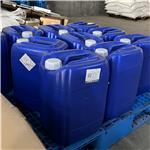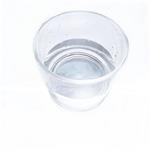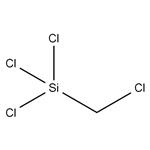Chemical Properties
Trichloro(chloromethyl)silane is a colorless liquid. Sharp, biting odor.
Chemical Properties
Colorless clear liquid
Uses
(chloromethyl)trichlorosilane is usede in the synthesis of a highly branched polycarbosilane. Ferrocenophane has been prepared from (chloromethyl)trichlorosilane.
Definition
ChEBI: Trichloro(chloromethyl)silane is a silyl chloride.
General Description
Liquid.
Air & Water Reactions
Highly flammable. Reacts vigorously with water to form hydrogen chloride (hydrochloric acid)
Reactivity Profile
Chlorosilanes, such as (Chloromethyl)trichlorosilane, are compounds in which silicon is bonded to from one to four chlorine atoms with other bonds to hydrogen and/or alkyl groups. Chlorosilanes react with water, moist air, or steam to produce heat and toxic, corrosive fumes of hydrogen chloride. They may also produce flammable gaseous H2. They can serve as chlorination agents. Chlorosilanes react vigorously with both organic and inorganic acids and with bases to generate toxic or flammable gases.
Health Hazard
(Non-Specific -- Methyl Trichlorosilane) If inhaled, may be harmful; contact may cause burns to skin and eyes. Runoff from fire control or dilution water may cause pollution.
Fire Hazard
(Non-specific -- Methyl Trichloro- silane) Flammable/Combustible material; may be ignited by heat, sparks, or flames. Vapors may travel to a source of ignition and flash back. Container may explode in heat of fire. Vapor explosion hazard indoors, outdoors, or in sewers. Runoff to sewer may create fire or explosion hazard. May react violently with water.
Potential Exposure
Used in the synthesis of polysiloxane (silicone polymers).
Shipping
UN3389 Toxic by inhalation liquid, corrosive, n.o.s. with an LC50 ≤200 mL/m3 and saturated vapor concentration ≥500 Hazard Class: 6.1; Labels: 6.1-Poisonous materials, 8-Corrosive material, Technical Name Required, Inhalation Hazard Zone A. UN1295 Trichlorosilane, Hazard Class: 4.3; Labels: 4.3-Dangerous when wet material, 3-Flammable liquid, 8-Corrosive material.
Incompatibilities
Incompatible with oxidizers (chlorates, nitrates, peroxides, permanganates, perchlorates, chlorine, bromine, fluorine, etc.); contact may cause fires or explosions. Keep away from alkaline materials, strong bases, strong acids, oxoacids, epoxides. Chlorosilanes react vigorously with bases and both organic and inorganic acids generating toxic and/or flammable gases. Chlorosilanes react with water, moist air, or steam to produce heat and toxic, corrosive fumes of hydrogen chloride. They may also produce flammable gaseous hydrogen. Attacks metals in the presence of moisture.





